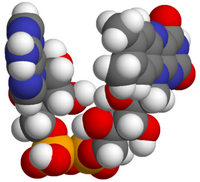
Photo from wikipedia
The electron configuration of flavin cofactors, FMN and FAD, is a critical factor governing the reactivity of NADPH-cytochrome P450 reductase (CPR). The current view of electron transfer by the mammalian… Click to show full abstract
The electron configuration of flavin cofactors, FMN and FAD, is a critical factor governing the reactivity of NADPH-cytochrome P450 reductase (CPR). The current view of electron transfer by the mammalian CPR, based on equilibrium redox potentials of the flavin cofactors, is that the two electron-reduced FMN hydroquinone (FMNH2), rather than one electron-reduced FMN semiquinone, serves as electron donor to the terminal protein acceptors. However, kinetic and thermodynamic studies on the CPR species originated from different organisms have shown that redox potentials measured at distinct electron transfer steps differ from redox potentials determined by equilibrium titration. Collectively, previous observations suggest that the short-lived transient semiquinone species may carry electrons in diflavin reductases. In this work, we have investigated spectroscopic properties of the CPR-bound FAD and FMN reduced at 77 K by radiolytically-generated thermalized electrons. Using UV-vis spectroscopy, we demonstrated that upon cryo-reduction of oxidized yeast CPR (yCPR) containing an equimolar ratio of both FAD and FMN, or FAD alone, neutral semiquinones were trapped at 77 K. During annealing at the elevated temperatures, unstable short-lived neutral semiquinones relaxed to spectroscopically distinct air-stable neutral semiquinones. This transition was independent of pH within the 6.0-10.7 range. Our data on yeast CPR are in line with the previous observations that the flavin short-lived transient semiquinone intermediates may have a role in the electron transfer by CPR at physiological conditions.
Journal Title: Archives of biochemistry and biophysics
Year Published: 2019
Link to full text (if available)
Share on Social Media: Sign Up to like & get
recommendations!